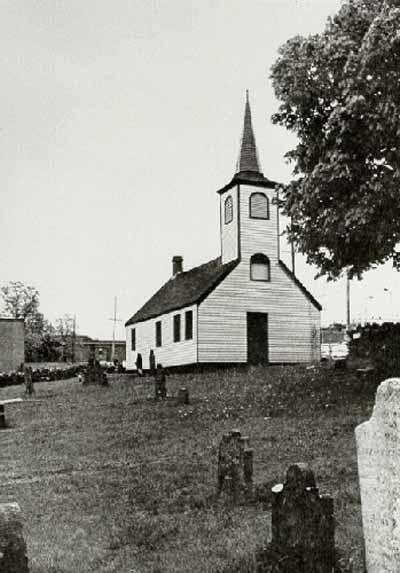Little Dutch (Deutsch) Church National Historic Site of Canada
Halifax, Nova Scotia

General view
© Parks Canada Agency / Agence Parcs Canada, 1965.
Address :
2393 Brunswick Street, Halifax, Nova Scotia
Recognition Statute:
Historic Sites and Monuments Act (R.S.C., 1985, c. H-4)
Designation Date:
1997-09-22
Dates:
-
1756 to 1760
(Construction)
Event, Person, Organization:
-
Lutheran religion
(Organization)
-
Anglican Church
(Organization)
-
German Canadians
(Organization)
-
Christopher Cleesattel
(Builder)
Other Name(s):
-
Little Dutch (Deutsch) Church
(Designation Name)
Research Report Number:
1996-002
Plaque(s)
Existing plaque: 2393 Brunswick Street, Halifax, Nova Scotia
This modest church and burial ground bear eloquent witness to the German-speaking people who settled in the British colony of Nova Scotia in the mid-18th century. The burying ground was set aside in 1752 for the recently arrived immigrants from Europe, who formed a cohesive community based on their shared language and faith. They erected this building by 1756, and it served as church, school and social centre well into the 19th century. An enduring symbol of the early history of Halifax and the Foreign Protestants of Nova Scotia, it is the oldest church associated with German immigration to Canada.
Description of Historic Place
Located in Halifax's north end, the Little Dutch (Deutsch) Church National Historic Site of Canada stands within an evocative 18th-century burying ground, surrounded by a stone wall. This modestly sized wooden structure is a remnant of the city's early years and features a simple rectangular plan, a gable roof and spired tower that stands in contrast to the surrounding 19th-century mansions and 20th-century highrises. The formal recognition consists of the church on its legal property at the time of recognition.
Heritage Value
The Little Dutch (Deutsch) Church was designated a national historic site of Canada in 1996 because: it is the oldest known surviving church in Canada associated with the German Canadian community. it stands as a witness to early European settlement in Canada and, in its pioneer construction, it is a remarkable survivor from the period of Halifax's establishment. the Church and its 18th-century burying ground, one of the few surviving outside of Quebec, constitute a rare, intact ecclesiastical landscape of the time.
The Little Dutch (Deutsch) Church is located on a pre-existing burying ground which had been set aside in 1752 for the recently arrived German-speaking immigrants who formed a cohesive community based on their shared language and faith. The group acquired a building in 1756 that was moved to these burial grounds and adapted for its present. By 1758, the interior was finished by parishioners under the direction of joiner Christopher Cleestattel. In 1760, the church was extended to the north to support a belltower housing a bell taken from Louisbourg. The burial ground continued in use throughout most of the 19th century. Stone walls were erected around its perimeter in 1919.
While offering Lutheran services, the church was officially part of St. George's Anglican parish and, with the inflow of more English-speaking settlers into the area and the construction of St. George's round church in 1800, the religious role of the little church diminished. It continued to serve the German-speaking community as a school and social centre into the 19th century. While undergoing occasional repair and renovation, it has remained essentially intact.
Source: Historic Sites and Monuments Board of Canada, Minutes, June 1996.
Character-Defining Elements
Key elements contributing to the heritage value of the site include: the intact landscape of burying ground and church; its defining stone walls; its collection of early grave markers, haphazardly set within the uneven, sloping ground and those off-site; the siting of the church at the southwest corner of the lot; its small scale, rectangular massing, pitched roof and belfry with polygonal spire; its simple exterior delineation with four openings on each side elevation and central entry door on a gable end; the original placement of doors and windows; its wood construction and sheathing on a stone and brick foundation; the evidence of 18th-century construction techniques; the interior layout with vestibule, service compartments, open nave and chancel; its simple wooden furnishings and finishes with lath and plaster coved ceiling and walls; the basement crypt with its remnant brick vaults.